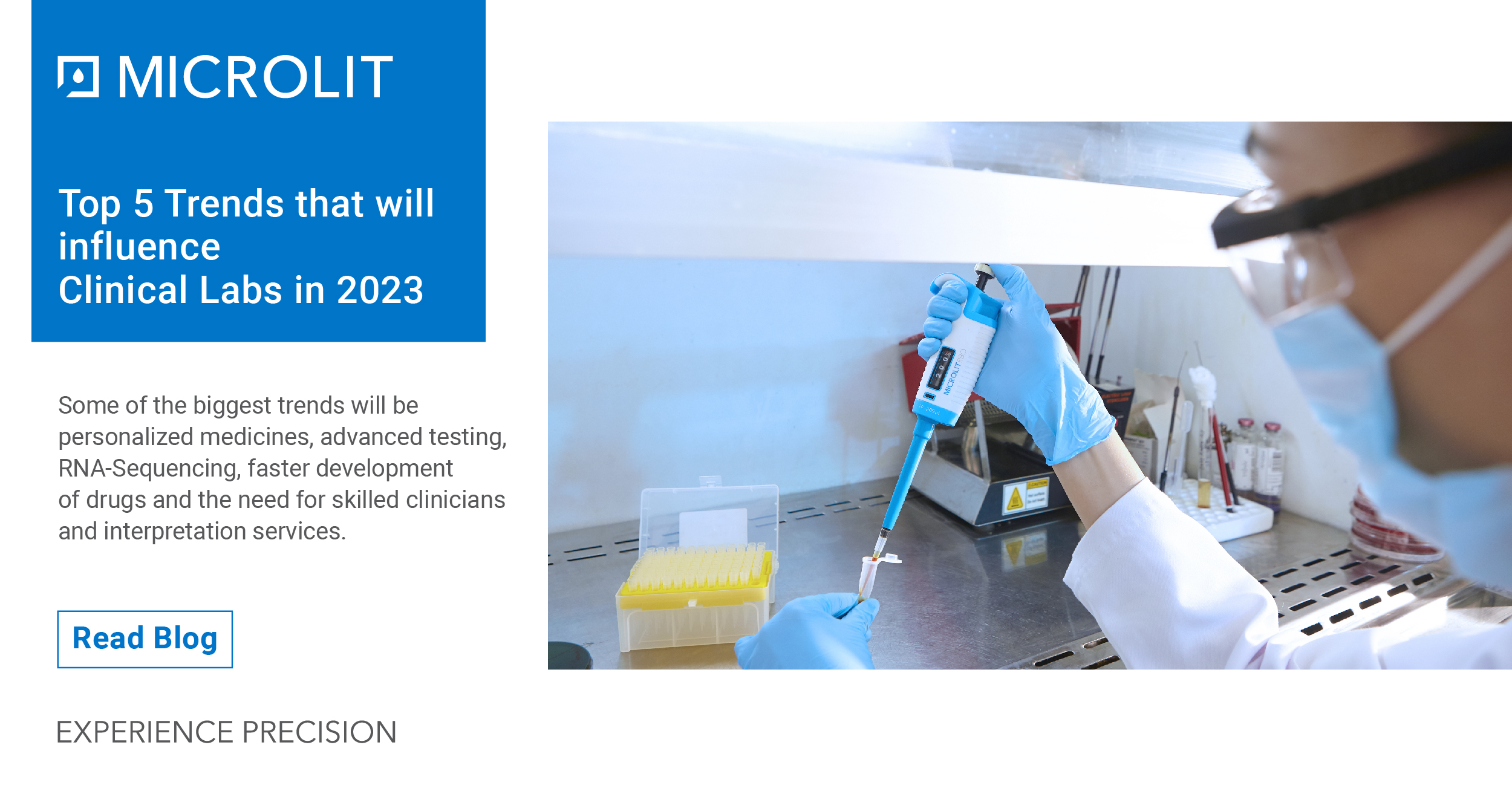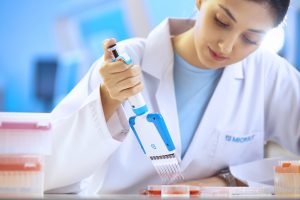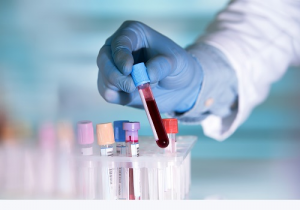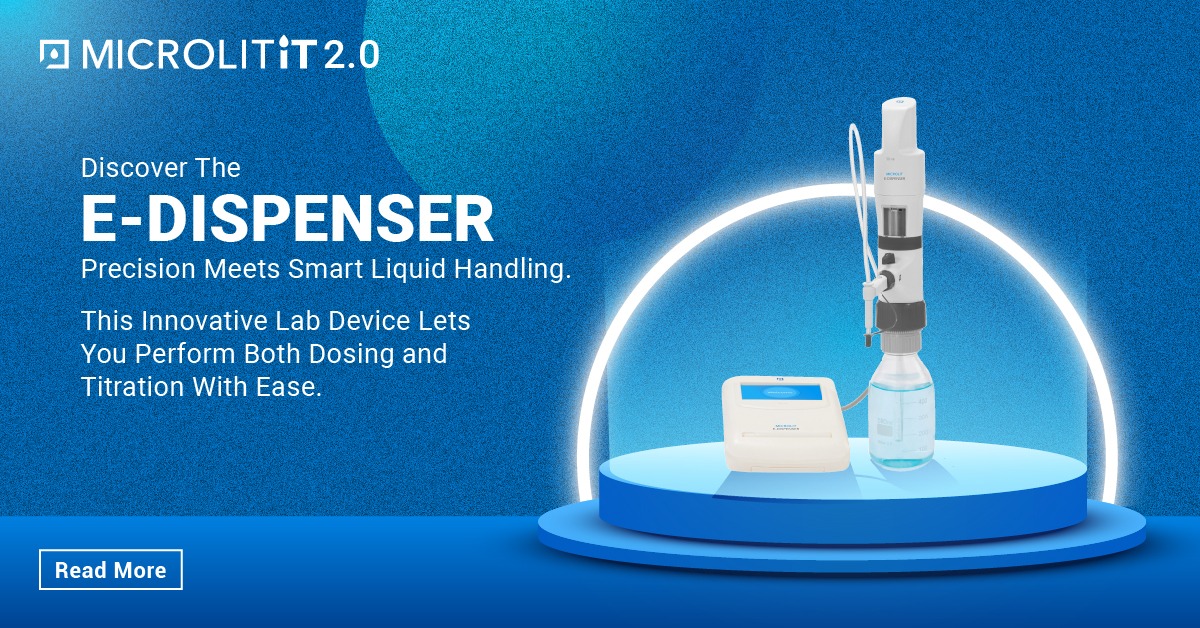Top 5 Trends that will influence Clinical Labs in 2023
- June 28, 2023
- ENQUIRE NOW

With clinical laboratories taking centre stage after COVID-19 by developing tests, collaborating with a diverse group of companies, ramping up test activities and servicing patients virtually by telehealth, a new report has identified the key factors set to impact the clinical laboratory market going forward.
 Personalised medicine, complex testing, RNA sequencing (RNA-Seq), the expedition of drug development and analytics through clinical trials, accelerated consumerisation and specialised training or qualified laboratory physicians and clinical interpretation services will be the top trends in 2023 in the industry.
Personalised medicine, complex testing, RNA sequencing (RNA-Seq), the expedition of drug development and analytics through clinical trials, accelerated consumerisation and specialised training or qualified laboratory physicians and clinical interpretation services will be the top trends in 2023 in the industry.
Growth opportunities for laboratories in the region, including innovative diagnostic tests for varied therapeutic segments at lower costs to patients, including broader test menus such as advanced testing in oncology, neurology and infectious diseases.
Other areas for growth include the expansion of digital health access with on-demand diagnostic tools and services, with laboratories capitalising on the shift toward care at home with at-home service offerings and approved, clinically valid tests with high specificity and sensitivity. Digital pathology features such as the implementation of Artificial Intelligence (AI), data science, and bioinformatics is another area for potential growth. This will make healthcare more affordable, accessible and scalable.
Rounding out the growth opportunities are patient-centric, holistic care management programs for personalised care, whereby laboratories and other diagnostic stakeholders must meet the demand for centred access to virtual care with at-home testing and hospital-at-home services.
#1 – The 2023 Flu Season Will Likely Be the Worst Since the Onset of the Pandemic
Last year harboured fears that the 2022 flu season would usher in a “twindemic,” further straining overstretched hospital and clinical laboratory resources. That prediction was wrong—thankfully—but of all the predictions on this year’s list, this appears to be the one most likely to come true.
Since society has opened back up and disease countermeasures have relaxed—e.g. social distancing, masking, and testing across the world, look on track to have a tough, or at least tougher, flu season than in recent years.
Following the successful rollout of the COVID-19 vaccination program last year, populations are beginning to have increased levels of interactions once again as restrictions have been lifted. This poses a risk of co-infections of COVID-19 with other respiratory pathogens. These co-infections could cause complications in the diagnosis, treatment, and prognosis of patients, putting pressure on healthcare systems. Any future vaccination programs, therefore, would most likely involve a combination of COVID-19 and Influenza strains, especially for the most vulnerable groups, such as the elderly or immune-compromised individuals.
#2 – Staff Shortages Will Drive the Need to Increase Automation Processes
Perhaps as a sign of clinical laboratories themselves returning to normal is the renewed focus on a perennial problem: staff shortages, along with a need to invest in automation. By implementing the right technology and adding automation where possible to clinical and billing workflows, labs will be able to fill the gaps created by a lack of qualified personnel. They’ll also enjoy streamlined and more efficient operations. And because of this need, it’s predicted that there will be more automated solutions to choose from.
Laboratories will leverage the automation they have been given access to during the pandemic and drive the consolidation of testing on fully automated platforms. AI can have a significant impact across all different areas of testing by optimizing workflow, testing sequence, result interpretation, and result augmentation. AI can also provide lab techs longer walk-away times and allow them to focus their skills, attention, and expertise on more complex work.
While automation will likely help alleviate some of the burdens of staff shortages in the clinical laboratory, finding personnel will continue to dominate operational efficiency.
#3 – Direct-to-Consumer Solution and Telemedicine Will Open New Revenue Channels for Clinical Laboratories
In the wake of every major crisis, typically there are deep-seated cultural changes that inform the way we live. This is particularly the case with COVID-19; home testing has become ubiquitous. And because patients now expect it, clinical laboratories diagnostic testing is shifting further from traditional collection sites, such as providers’ offices or hospitals to homes and pharmacies. In 2023, as options for self-collection and at-home testing will grow, there will ultimately be higher volumes of samples which need to be sent to laboratories to be tested. Advances in technology and a combination of consumerism and proactive management of healthcare by patients will further open up new revenue channels for clinical laboratories this year.
#4 – Molecular and Other Advanced Testing Types Will Gain Further Footholds
A bold prediction sees molecular testing as the future of diagnostics.
 Polymerase Chain Reaction (PCR) technology has established itself as the gold standard for COVID-19 testing. The entire scientific community, including medical professionals, public policymakers, regulatory bodies, and test manufacturers, has seen the merits of PCR testing for infectious diseases. There will be a need to expand the infectious disease testing menu beyond SARS-COV-2. Multiplex tests, including targeted panels as well as a syndromic panel for specific indications, will continue to become the norm. These new, highly educated, consumers will expect a test that is accurate, and quick, which are qualities that PCR testing uniquely provides over traditional culture-based methods.
Polymerase Chain Reaction (PCR) technology has established itself as the gold standard for COVID-19 testing. The entire scientific community, including medical professionals, public policymakers, regulatory bodies, and test manufacturers, has seen the merits of PCR testing for infectious diseases. There will be a need to expand the infectious disease testing menu beyond SARS-COV-2. Multiplex tests, including targeted panels as well as a syndromic panel for specific indications, will continue to become the norm. These new, highly educated, consumers will expect a test that is accurate, and quick, which are qualities that PCR testing uniquely provides over traditional culture-based methods.
Workflow efficiency will continue to be a primary topic of conversation as labs work hard to calibrate to staffing constraints. Creative, affordable solutions will be sought by health systems to maintain levels of service while supporting high-quality clinical care. Companies able to offer innovative solutions to support both lab productivity and high quality will continue to be successful. The evolution of digital health including the integration of multiple data sets, remote diagnostics, and artificial intelligence is expected to accelerate to support distributed lab operations, data management, and data interpretation.
#5 – AI and Machine Learning will Drive Personalized Care
It is becoming clear that a blanket approach to patient care isn’t always effective. AI and machine learning will help pathologists and primary care providers to develop more personalized approaches to cancer and other treatments.
Artificial Intelligence would streamline workflows, improve accuracy, and free up scientists to focus on more complicated cases. There are currently some barriers to adoption, for example, data storage limitations and a lack of clinical evidence on accuracy. However, as data storage solutions become more affordable year after year, and machine learning/computer processing powers increase reliability, trust will grow and these challenges will be overcome.
This personalized approach to care will extend throughout the healthcare enterprise.
Pour in your thoughts/ideas/suggestions at info@microlit.com or to know about MICROLIT products, visit our website www.microlit.com





